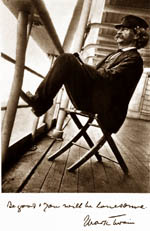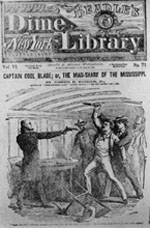 Steamboats on America's Rivers
Steamboats on America's Rivers Steamboats on America's Rivers
Steamboats on America's Rivers"The steamboats were finer than anything on shore. Compared with superior dwelling-houses and first-class hotels in the valley, they were indubitably magnificent, they were 'palaces'."
 |
| The modern American Queen |
Published in 1883, Twain's Life on the Mississippi
describes
the people that made steamboats so popular. Twain, or Samuel Clemmons,
knew from a life growing up on the Mississippi during the advent and apex
of steamboating, that these impressive vessels were a unique American statement.
This picture shows Twain relaxing on the deck of one such boat.

Steamboats became the way to travel in the first third of the
nineteenth century. Once reliable steam power was refined, steamboats
quickly became vehicles of speed, power, and luxury. Designers made
the boats wide with shallow drafts so they could operate in a variety of
conditions. The most luxurious were floating hotels providing their
passengers with the best of everything. Most carried both passengers
and cargo, increasing the volume of trade throughout the United States. 
More than just transportation, steamboats reflected American culture. The United States was expanding and traveling the country's great rivers by steam was emblematic of westward growth. Not only were steamboats representative of the expansionist American spirit, but they captured well America's potential. On board later paddlewheelers travelers could find gambling, fine dining, and a variety of entertainments. By the middle of the nineteenth century the grand ballrooms and casinos of riverboats became settings that American writers used to depict adventure stories of daring gamblers and hard-luck heroes.